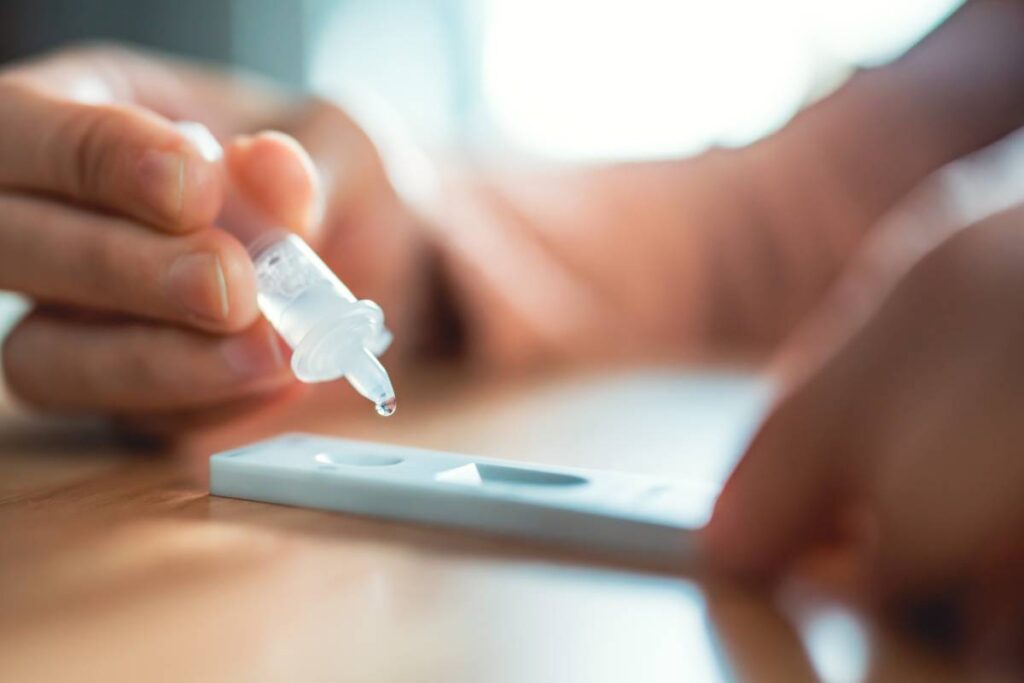Testing for Covid has been a key tool in the global fight against the pandemic since its early stages, though implementation has varied by country. Tests for detecting SARS-CoV-2 were developed within days of the release of the virus genome (1). China, where the virus was first detected, had already begun limited testing by the start of 2020, and many other countries quickly followed suit. In early February 2020, South Korea began to offer open public testing, as the first country to do so (2). Testing technology quickly advanced and at-home rapid antigen tests in particular have greatly transformed daily life for Americans. However, it is necessary to evaluate how effective self-testing for Covid is, given that mishandling or misinterpretation of the test can interfere with its efficacy (3).
There are several different types of Covid tests available currently. One distinction is what is being tested for – virus or viral biomarker tests look for active infection, while antibody tests look for prior infection (4). The former is important for controlling infections, while the latter is useful for research on immunity and post hoc analysis. Tests for infection can further be divided in nucleic acid amplification tests – including PCR tests – and antigen tests (though other types are also being developed), as well as laboratory vs. rapid tests (4). Self-testing for Covid usually uses rapid antigen detection and has many benefits, including allowing people to test without needing to find a testing location and potentially exposing others, decreasing the burden on health systems, and easing the transition back to normal life as individuals can quickly test before going to events or spending time with vulnerable people (1,4).
Significant research has been devoted to Covid testing strategies since early in the pandemic. For example, a team of researchers simulated the efficiency of mass testing in March of 2020 to provide guidance for public health responses to the spread of Covid. Widespread testing is a key component of infection control, but individual testing requires huge amounts of resources. Instead, pooled or high throughput approaches may be considered (5). In fact, this strategy has been implemented with success in many settings, including universities and cities. However, this type of testing still has major drawbacks, including the need for trained technicians and the disruption to daily life.
The first at-home Covid test received emergency use authorization by the FDA in December 2020 (6). Public health officials hoped that self-testing would demonstrate high efficacy and increase the average frequency of Covid tests, as frequent and large-scale testing is key to controlling the spread of Covid (1,3,4,5). Two of the drawbacks of rapid at-home tests, which are antigen-based, are a) potentially lower sensitivity in asymptomatic or mild cases compared to PCR tests and b) needing individuals to properly administer the test and interpret results (3,4).
To this end, Papenburg et al. performed a prospective cross-sectional study in the workplace setting. Participants were untrained, worked at a business with 2 or more active cases, and did not meet quarantine requirements. They then received either manufacturer instructions or instructions that were modified based on common errors. Over 600 participants performed roughly three tests each on average. The modified instructions significantly improved accuracy for those with invalid, weak positive, positive, or strong positive results on their first test, and for those with invalid, weak positive, or positive results on their second test. Adherence to key procedural steps was unchanged (3).
Covid self-testing is a useful tool in controlling infections and can have high efficacy when properly utilized. However, there are arguably more weak points compared to tests administered by trained technicians. The study by Papenburg et al. identified the interpretation of results as an area that can be improved through the simple change of clearer instructions. Alongside PCR tests, vaccination, and individual physical prevention measures, many tools are available for controlling and reducing the spread of Covid.
References
- Mina MJ, Andersen KG. COVID-19 testing: One size does not fit all. Science, 2020;371(6525):126-127. DOI: 10.1126/science.abe9187
- “COVID-19 Testing Policies.” Our World In Data (n.d.). https://ourworldindata.org/grapher/covid-19-testing-policy
- Papenburg J, Campbell JR, Caya C, et al. Adequacy of Serial Self-performed SARS-CoV-2 Rapid Antigen Detection Testing for Longitudinal Mass Screening in the Workplace. JAMA Network Open, 2022;5(5):e2210559. doi:10.1001/jamanetworkopen.2022.10559
- “COVID-19 Testing: What You Need to Know.” CDC (May 3, 2022). https://www.cdc.gov/coronavirus/2019-ncov/symptoms-testing/testing.html
- Deckert A, Bärnighausen T, Kyei NNA. Simulation of pooled-sample analysis strategies for COVID-19 mass testing. Bulletin of the World Health Organization, 2020; 98:590–598. DOI: 10.2471/BLT.20.257188
- “In Vitro Diagnostics EUAs – Antigen Diagnostic Tests for SARS-CoV-2.” FDA (May 19, 2022). https://www.fda.gov/medical-devices/coronavirus-disease-2019-covid-19-emergency-use-authorizations-medical-devices/in-vitro-diagnostics-euas-antigen-diagnostic-tests-sars-cov-2



